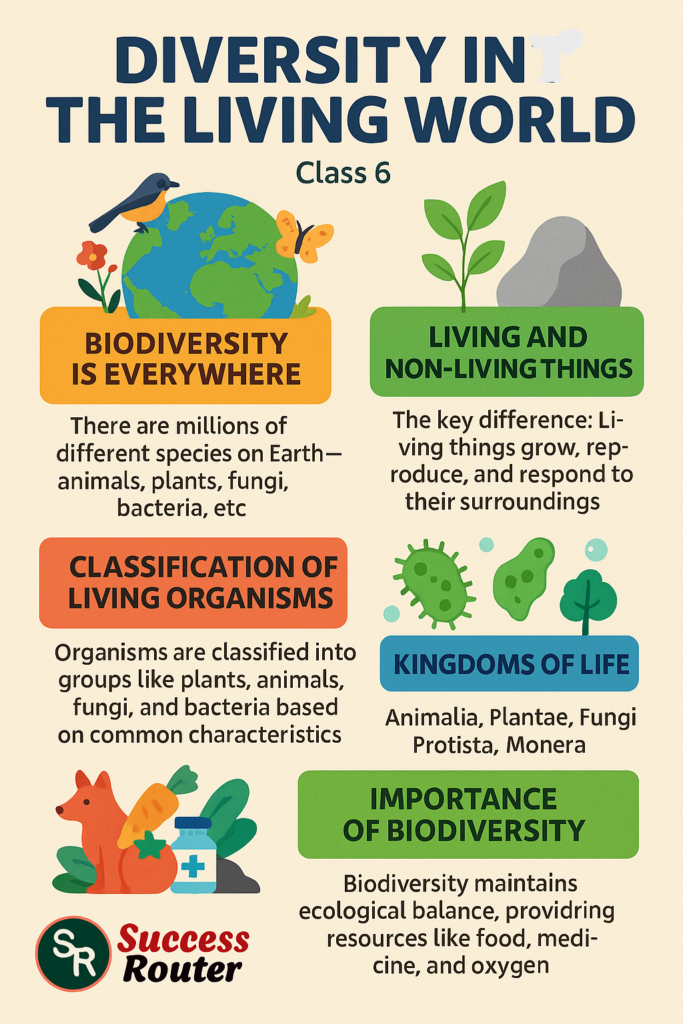Last Updated on October 13, 2025 by XAM CONTENT
New book for CBSE Class 6 Curiosity, Textbook of Science for Grade 6 learners has been published by NCERT as per National Education
Policy (NEP) 2020. Curiosity, Textbook of Science for Grade 6, comprises twelve chapters. Through the chapters, learners will embark on a journey that will connect them to the world around and spark curiosity for further exploration.
We are providing case study questions for class 6 science. Case study questions are the new question format that is introduced in CBSE board. The resources for case study questions are very less. So, to help students we have created chapterwise case study questions for class 6 science. In this article, you will find case study questions for cbse class 6 science chapter 2 Diversity in the Living World.
| Chapter | Diversity in the Living World |
| Textbook Name | Curiosity |
| Publication Date | July 2024 |
| Type of Questions | Case Study Questions |
| Nature of Questions | Competency Based Questions |
| Board | CBSE |
| Class | 6 |
| Subject | Science |
| Useful for | Class 6 Studying Students |
| Answers provided | Yes |
| Difficulty level | Mentioned |
| Important Link | Class 6 Science Chapterwise Case Study |
Case Study Questions on Diversity in the Living World
Questions
Passage 1:
Read the given passage below and answer the questions.
The pictures show four different plants.

Q. 1. Which plants have the same type of roots?
(a) Only plant 1 and plant 2
(b) Only plant 2 and plant 3
(c) Plant 1, plant 2 and plant 3
(d) Plant 2, plant 3 and plant 4
Ans. Option (c) is correct.
Explanation: All 3 plants have tap roots while plant 4 has fibrous roots.
Q. 2. Why is the root of plant 1 is thick and round?
Ans. Plant 1 is thick and round primarily due to its role as a storage organ for the plant. The plant 1 is actually a swollen taproot, which serves to store nutrients and energy for the plant. This storage function helps the plant survive through periods of adverse conditions, such as winter.
Passage 2:
Grouping for Clarity
The teacher gave students a task: group items like books, bags, bottles, and lunch boxes. Then they discussed grouping plants and animals too—based on roots, leaves, flowers, ability to move, or where they live. Grouping helps in studying them better and finding similarities.
Q1. Why did the teacher ask students to group objects?
(a) To play a game
(b) To clean the classroom
(c) To understand how classification helps in learning
(d) To count them
Difficulty Level: Easy
Answer: (c) To understand how classification helps in learning
Q2. Which feature is not useful in classifying plants?
(a) Number of roots
(b) Colour of flowers
(c) Type of leaves
(d) Brand of seed packet
Difficulty Level: Medium
Answer: (d) Brand of seed packet
Q3. Grouping helps in:
(a) Making everything look similar
(b) Studying things easily by observing similarities
(c) Getting rid of animals
(d) Changing plant features
Difficulty Level: Easy
Answer: (b) Studying things easily by observing similarities
Q4. Which of these is a correct basis for grouping animals?
(a) Their color
(b) Their movement
(c) Their taste
(d) Their smell
Difficulty Level: Medium
Answer: (b) Their movement
Also check:
- Beyond Earth Class 6 Case Study Questions Science Curiosity Chapter 12
- Nature’s Treasures Class 6 Case Study Questions Science Curiosity Chapter 11
- Living Creatures Class 6 Case Study Questions Science Curiosity Chapter 10
- Methods of Separation in Everyday Life Class 6 Case Study Questions Science Curiosity Chapter 9
- A Journey Through States of Water Class 6 Case Study Questions Science Curiosity Chapter 8
- Temperature and Its Measurement Class 6 Case Study Questions Science Curiosity Chapter 7
- Materials Around Us Class 6 Case Study Questions Science Curiosity Chapter 6
- Measurement of Length and Motion Class 6 Case Study Questions Science Curiosity Chapter 5
- Exploring Magnets Class 6 Case Study Questions Science Curiosity Chapter 4
- Mindful Eating Class 6 Case Study Questions Science Curiosity Chapter 3
- Diversity in the Living World Class 6 Case Study Questions Science Curiosity Chapter 2
- The Wonderful World of Science Class 6 Case Study Questions Science Curiosity Chapter 1
🚀 Boost Your Exam Prep: Get case study questions for all subjects (Class 6-12) now!
👉 Explore more resources on CBSE Class 6
You may also like
Learning Objectives
- Identify and define the concept of biodiversity, including the variety of life forms and their interactions within ecosystems.
- Observe and record different characteristics of plants and animals during field activities.
- Classify plants and animals based on traits such as stem type, leaf structure and movement patterns.
- Understand the importance of each organism’s role in maintaining ecological balance and the need for conservation.
Desert snakes burrow deep into the sand during the day to escape the scorching heat of the desert sun. The deeper layers of sand are significantly cooler than the surface, providing a much more comfortable environment for the snake.
Keywords Related to Diversity in the Living World
- Biodiversity: The variety of life forms in an ecosystem, including plants, animals and microorganisms.
- Adaptations: Special features or behaviours that enhance survival in specific environments.
- Ecosystem: A community of living organisms interacting with their physical environment.
- Camouflage: A survival strategy where an organism blends into its environment to avoid predators.
- Mimicry: The resemblance of one organism to another for protection or predatory advantage.
- Habitat: The natural environment where an organism lives and thrives.
- Pollination: The transfer of pollen from male to female plant structures, facilitating reproduction.
🔗👉 Read Also: NCERT Solutions for Class 1 to 12

Frequently Asked Questions (FAQs) on Diversity in the Living World Case Study Questions
Q1: What is the new Science textbook “Curiosity” for Grade 6 about?
A1: he new textbook “Curiosity” for Grade 6 Science introduces students to the world of scientific exploration and discovery. It focuses on fostering curiosity and encouraging students to ask questions, observe the world around them, and engage in hands-on activities to understand scientific concepts.
Q2: How is the “Curiosity” textbook different from previous Science textbooks?
A2: “Curiosity” is designed to be more engaging and interactive than previous Science textbooks. It emphasizes inquiry-based learning, where students are encouraged to explore and discover through experiments, observations, and critical thinking rather than just memorizing facts. The textbook is structured around real-world phenomena and everyday experiences to make learning more relevant and exciting for students.
Q3: What are the key themes covered in the “Curiosity” textbook?
A3: The “Curiosity” textbook covers a wide range of themes, including the natural world, physical processes, and basic principles of life sciences. It explores topics such as the properties of materials, the functioning of living organisms, energy, forces, and environmental studies, all while emphasizing the importance of curiosity and inquiry in the learning process.
Q4: How does “Curiosity” support the development of scientific thinking in students?
A4: “Curiosity” supports the development of scientific thinking by encouraging students to ask questions, make observations, conduct experiments, and analyze their findings. The textbook includes activities and projects that help students apply the scientific method, fostering critical thinking, problem-solving, and a deeper understanding of scientific concepts.
Q5: How does “Curiosity” prepare students for higher grades in Science?
A5: “Curiosity” lays a strong foundation for higher grades by introducing students to key scientific concepts and developing their inquiry-based learning skills. By fostering curiosity, critical thinking, and problem-solving abilities, the textbook prepares students for more advanced scientific studies in the middle and high school levels.
Q6: What is biodiversity?
A6: Biodiversity refers to the variety of life forms on Earth, including all living organisms, their interactions and ecosystems.
Q7: What is a taproot system?
A7: A taproot system has a central, thick root with smaller lateral roots branching out, typically found in dicots
Q8: What is the role of curiosity in learning science?
A8: Curiosity leads to observation, questioning, and exploration.
Q9: How does students observe and record animal movements during the nature walk?
A9: Students observe the body parts used for movement, such as legs, wings, or fins and record how animals move,
including whether they fly, swim, crawl, or walk.
Q10: Are there any online resources or tools available for practicing class 6 science “Diversity in the Living World” case study questions?
A10: We provide case study questions for CBSE Class 6 Science on our website. Students can visit the website and practice sufficient case study questions and prepare for their exams. If you need more case study questions, then you can visit Physics Gurukul website. they are having a large collection of case study questions for all classes.



